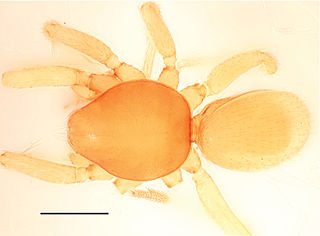
Oonopidae, also known as goblin spiders, is a family of spiders consisting of over 1,600 described species in about 113 genera worldwide, with total species diversity estimated at 2000 to 2500 species. The type genus of the family is OonopsKeyserling, 1835.

Norman Ira Platnick was an American biological systematist and arachnologist. At the time of his death, he was a professor emeritus of the Richard Gilder Graduate School and Peter J. Solomon Family Curator Emeritus of the invertebrate zoology department of the American Museum of Natural History. A 1973 Ph.D. recipient at Harvard University, Platnick described over 1,800 species of spiders from around the world, making him the second most prolific spider taxonomist in history, behind only Eugène Simon. Until 2014 he was also the maintainer of the World Spider Catalog, a website formerly hosted by the AMNH which tracks the arachnology literature, and attempts to maintain a comprehensive list, sorted taxonomically, of every species of spider which has been formally described. In 2007 he received the International Society of Arachnology's Bonnet award, named for Pierre Bonnet, in recognition of his work on the catalog.
Oonops is a genus of spiders mostly found in America, Europe to Russia and East and North Africa.

Unicorn ("one horn", in Latin) is a genus of goblin spiders from South America, containing seven species that occur predominantly in high elevation, semi-desert regions of Bolivia, Chile, and Argentina. Individuals are relatively large for goblin spiders, measuring up to 3.0 mm (0.12 in) in body length. The genus name refers to a characteristic pointed projection between the eyes and jaws of males. In at least one species, broken-off tips of the male pedipalps have been found within the genitalia of females, postulated as a means of sperm competition. Unicorn possesses several traits that suggest it is a relatively "primitive" member of the Oonopidae, and is classified with other similar, soft-bodied goblin spiders in the subfamily Sulsulinae.

Triaeris stenaspis is a species of spider in the family Oonopidae, with a pantropical distribution. It is also found in Iran and has been introduced into Europe. A very small spider, with a maximum body length of under 2 mm (0.08 in), it has been shown to prey successfully on springtails. Only females have ever been found, and the species may be parthenogenetic, being able to produce female offspring from unfertilized eggs.
Predatoroonops is a genus of goblin spiders endemic to the Brazilian Atlantic Forest. The genus is characterized by the extremely modified male chelicerae and long pairs of ventral spines. It is the first fully revised endemic Brazilian genus of spiders, uncovered in 2012 after two and a half years of research at São Paulo's Instituto Butantan.
Oonops hasselti is a spider species found in Scandinavia.
Oonops lubricus is a spider species found in France.
Oonops mahnerti is a spider species found in Greece.
Oonops placidus is a spider species found in France.
Oonops procerus is a spider species found in France and Spain.
Oonops tubulatus is a spider species found in Portugal and Algeria.

Bannana is a genus of goblin spiders native to Xishuangbanna prefecture, Yunnan Province, China, where it lives in the leaf-litter of tropical rainforest. There are two known species: Bannana crassispina and B. parvula, both described in 2015. Individuals are pale yellow and unpatterned, and range from around 1.0 to 1.8 mm in body length, with females being slightly larger than males. The eyes are reduced or entirely absent. Known only from a nature reserve in Xishuangbanna, Bannana belongs to a group of Asian goblin spiders known as the "Dysderoides complex", that ranges from China to Pakistan and south to Indonesia.
Cousinea is a genus of spiders in the family Oonopidae. It was first described in 2001 by Saaristo. As of 2017, it contains only one species, Cousinea keeleyi, found in the Seychelles.
Dysderoides is a genus of spiders in the family Oonopidae. It was first described in 1946 by Fage. As of 2017, it contains 6 species, found in Thailand and India.
Farqua is a genus of spiders belonging to the family Oonopidae. It was first described in 2001 by Saaristo. As of 2017, the genus includes only one species, Farqua quadrimaculata, which is found on the Farquhar Group islands in the Seychelles.
Hypnoonops is a genus of spiders in the family Oonopidae. It was first described in 1977 by Benoit. As of 2017, it contains only one species, Hypnoonops lejeunei found in Congo.
Barbara Baehr is a German research scientist, entomologist, arachnologist, and spider taxonomist. She has described over 400 new spider species, mostly from Australia. She is originally from Pforzheim, Germany.
Shuqiang Li is a Chinese arachnologist and a professor at the Institute of Zoology of the Chinese Academy of Sciences. Li is best known for his work with spiders and has described hundreds of new species and many genera. He is Editor in Chief of the journal Zoological Systematics.




